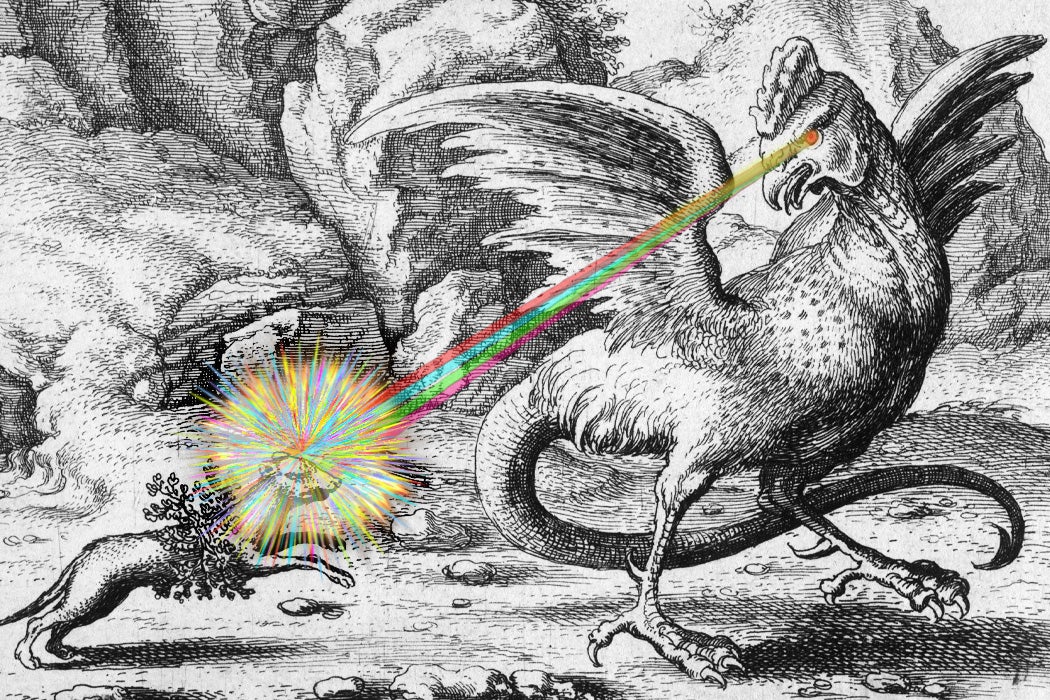The basilisk, which slays its victims with a single glance, seems as fantastical as the scorpion-tailed manticore or the Barnacle Tree, which sprouts goslings like fruit. But there was a perfectly reasonable scientific explanation for the basilisk’s lethal look: the extramission theory of vision.
According to the extramission theory, which was developed by such thinkers as Plato, Galen, Euclid, and Ptolemy, our eyes are more than the passive recipients of images. Rather, they send out eye-beams—feelers made of elemental fire that spread, nerve-like, to create our field of vision. These luminous tendrils stream out from our eyes into the world, apprehending objects in their path and relaying back to us their qualities.
The extramissionists proposed a theory of vision completely alien to our current way of thinking. Though they saw the world in the same way we did, the way they saw seeing was something else entirely. In the words of Empedocles:
…as when a man who intends to make a journey prepares a light for himself, a flame of fire burning through a wintry night… in the same way the elemental fire, wrapped in membranes and delicate tissues, was then concealed in the round pupil.
In this view, sight is essentially a species of touch. The extramissionist theory explained why it is that, as objects recede into the distance, their details blur: because they take up less of our visual field, there are fewer eye-beams to strike their surface and feel its intricacies.
Likewise, when objects are too far too see, it’s because our eye-beams can’t stretch far enough to reach them. This explains why squinting can help you see distant details: the narrowed aperture focuses your eye-beams onto a single point. The luminous gleam of a cat’s eyes in the dark was considered to be visible proof of the fire emanating from their pupils, and one philosopher proposed that the reason we get dizzy watching waves or wheels whirl is that following the motion with our eyes actually makes our eye-beams twist and churn.
Of course, there were objections. For instance, how is it that we can see the constellations the instant we turn our eyes to the night sky, if gazing on the stars means our visual tendrils must stretch far enough to touch them? To answer riddles like these, alternative versions of the theory developed. Some argued that, when our eyes meet the air, they convert the atmosphere itself into an organ of our senses. Others argued that the objects we see send out beams of their own, which meet and meld with the beams of our eyes.
Interestingly, the counter-theory to extramission—intromission—is almost equally alien. Democritus, an intromissionist, put forth this bizarre theory: the objects around us slough off a continuous stream of atom-thin flakes, called eidola, each a miniature replica of its source. Eidola float through the air until they meet our open eyes and stamp themselves into our perception. The best evidence for this theory, according to its proponents, was the fact that when you gaze into someone’s eyes you see a floating miniature of the scene around them—the eidola, captured.
Once a Week
The debate between intromissionists and extramissionists continued well into the Middle Ages, leaving a lasting imprint on art and literature. Byzantine icons, for instance, derived much of their reverential impact from the idea that worshippers were, in fact, caressing the holy object with their gaze. The depths and reliefs, the play of light and shadow, and the rich, shimmering textures were all meant to evoke the sensation of visual touch.
On the other hand, medieval writers found a less holy use for the concept—erotic poetry. Poets wrote of being pierced by the arrow-like gaze of their beloved, and revelled in the idea that meeting their lady’s eyes was in fact a kind of mutual caress. John Donne wrote one of the most striking depictions of extramissive sight when he penned these lines:
Our hands were firmly cemented
With a fast balm, which thence did spring;
Our eye-beams twisted, and did thread
Our eyes upon one double string.
As for the basilisk, if the rays of the eyes could touch you, it stood to reason that, under the right circumstances, they could also hurt you. Sir Thomas Browne expressed this best, writing “it is not impossible, what is affirmed of this animal, the visible rays of their eyes carrying forth the subtilest portion of their poison, which is received by the eye of man or beast, infecteth first the brain, and is from thence communicated to the heart.” For the extramissionists, looks could kill.







